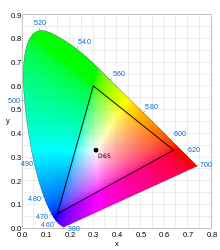This article possibly contains original research. (June 2023) |
| record. Code 709 | |
 BT.709 primaries shown on the CIE 1931 x, y chromaticity diagram. All chromaticities of the BT.709 color gamut fall within the triangle that connects the primaries. This includes Illuminant D65, the white point. | |
| Status | Approved |
|---|---|
| First published | November 16, 1993[1][2] |
| Latest version | BT.709-6 June 17, 2015[1][3] |
| Authors | ITU-R |
| Base standards | Rec.709, BT.709, ITU—709 |
| Domain | Digital image processing |
| Website | www |
Rec. 709, also known as Rec.709, BT.709, and ITU 709, is a standard developed by ITU-R for image encoding and signal characteristics of high-definition television.
The most recent version is BT.709-6 released in 2015. BT.709-6 defines the picture characteristics as having a (widescreen) aspect ratio of 16:9, 1080 active lines per picture, 1920 samples per line, and a square pixel aspect ratio.
The first version of the standard was approved by the CCIR as Rec.709 in 1990 (there was also CCIR Rec. XA/11 MOD F[4] in 1989), with the stated goal of a worldwide HDTV standard. The ITU superseded the CCIR in 1992, and subsequently released BT.709-1 in November 1993.[2] These early versions still left many unanswered questions, and the lack of consensus toward a worldwide HDTV standard was evident. So much so, some early HDTV systems such as 1035i30 and 1152i25 were still a part of the standard as late as 2002 in BT.709-5.[5]
- ^ a b "BT.709 : Parameter values for the HDTV standards for production and international programme exchange". www.itu.net. n.d. Retrieved April 19, 2021.
- ^ a b "BT.709: Basic parameter values for the HDTV standard for the studio and for international programme exchange". www.itu.net. Rec. 709-01. November 16, 1993. Retrieved April 19, 2021.
- ^ "BT.709 : Parameter values for the HDTV standards for production and international programme exchange". www.itu.net. Rec. 709-06. June 7, 2015. Retrieved April 19, 2021.
- ^ "Conclusions of the extraordinary meeting of study group 11 on high-definition television" (PDF). 1989.
- ^ "ITU-R BT.709-5". ITU-R.